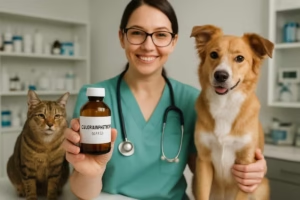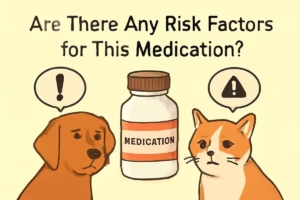What is chloramphenicol?
Chloramphenicol is a broad-spectrum drug commonly prescribed in veterinary medicine, especially for treating bacterial infections. Although it is approved for use in dogs and horses, it’s frequently used off label in a range of other animals, such as cats, rabbits, hedgehogs, rodents, ferrets, birds, and reptiles.. You can explore more about similar medications and their uses, such as Clindamycin for Dogs.
The term “off label” refers to when a drug is used in a way that has not been reviewed or approved by the U.S. Food and Drug Administration (FDA) or Health Canada. Despite not being formally authorized for certain animals, veterinarians often rely on their professional judgment, following their directions and taking necessary cautions when administering the drug.
In these cases, the use of chloramphenicol is based on its effectiveness in treating various bacterial infections, even though the approval may be significantly different from the usage outlined on the label. This practice of using drugs in an extra label manner is quite common in the field of veterinary medicine, where flexibility and expertise guide treatment options.

Although chloramphenicol is not always explicitly approved for all species, it still plays a crucial role in treating infections in a variety of animals, ensuring the health of pets and other animals under the care of a veterinarian.
By carefully considering the specific needs of each patient, veterinarians can navigate the complexities of off-label drug use, administering the proper doses while being mindful of the differences in reactions across species. It is crucial that pet owners understand the importance of following the veterinarian’s directions and cautions when using chloramphenicol for their pets. It’s always important to stay informed and follow the guidelines provided by health authorities like the FDA and Health Canada to ensure the safety of the animal.
Overview of Chloramphenicol (Chloromycetin®) for Dogs and Cats
Chloramphenicol (also known by its brand name Chloromycetin®) is an antibiotic that is highly effective in treating various infections in both dogs and cats. It works by inhibiting the growth of bacteria, thus suppressing bacterial growth. What makes it stand out is its ability to target a broad range of bacteria, and it also has some effectiveness against one-celled pathogenic organisms, including protozoa.
As a prescription drug, Chloramphenicol can only be obtained through a veterinarian’s prescription, ensuring that the drug is used properly and under professional guidance. This controlled access ensures its safety and appropriate usage in dogs and cats, making it a reliable option for various infections.
Its use in veterinary medicine is well-documented, though it is important to note that it should only be used as directed by a veterinarian, since it is a prescription medication. The prescription ensures that it is administered correctly and that the correct dose is given to treat the specific infection, making it an essential part of any veterinary treatment plan. As always, it’s crucial that pet owners follow the guidance and instructions provided by their veterinarian to ensure the health and safety of their pets.
Brand Names and Other Names of Chloramphenicol
Chloramphenicol is available in several formulations for both humans and animals. The brand name Chloromycetin®, which is produced by Parke-Davis, is widely recognized, but there are also various generic formulations available. The drug is registered for use in both humans and animals, ensuring that it can be safely prescribed across different species.
In the context of veterinary medicine, veterinary formulation options are available, allowing it to be used effectively in animals as part of their treatment. Whether in its branded or generic form, Chloromycetin® continues to be a versatile medication in both human and veterinary care.
How Chloramphenicol Works
Chloramphenicol is a powerful antibiotic for dogs and cats that works by preventing the development of proteins in susceptible strains of bacteria. These proteins are necessary for the bacteria to survive and replicate, making it an effective treatment for a variety of bacterial infections in pets, especially dogs and cats. For an alternative treatment for bacterial infections, consider checking out Clavamox Dosage for Dogs.
The ability of chloramphenicol to target these essential processes is what makes it a valuable tool in managing infections. However, while it is highly effective, it’s important to note that it can negatively affect the bone marrow in pets, which is why it is typically used under strict guidelines.
To combat potential risks like antibiotic resistance, chloramphenicol is often reserved for treating specific infections that have been determined by a veterinarian to be susceptible to the drug. In many cases, when alternative medications are not available, chloramphenicol becomes the preferred option. Its use in these situations is carefully managed, ensuring that it is only given when necessary and that the proper precautions are taken.
While chloramphenicol is widely used to treat infections, veterinarians are cautious about its use due to the potential side effects on the bone marrow and its possible contribution to antibiotic resistance. This is why it is important for pet owners to work closely with their veterinarian to ensure that it is the best choice for their pet’s health. The drug is only recommended when other treatments are not viable, and the benefits outweigh the potential risks.
Chloramphenicol is a broad-spectrum medication that is often used in dogs and cats to treat bacterial infections. It is FDA-approved for use in certain species, but it is also widely utilized in an off-label or extra-label capacity for other animals such as horses, birds, reptiles, ferrets, and small mammals.
In these cases, the veterinarian will rely on their direct and personal knowledge of the animal’s health and circumstances to determine if chloramphenicol is the right choice. The use of this drug outside its specified purposes is done with caution and is typically considered when no appropriate medications are available.
The way chloramphenicol works is by interfering with the bacterial ability to create essential proteins, ultimately preventing the bacteria from surviving and replicating. This makes it highly effective in treating a variety of bacterial infections in pets. Whether it’s being used for an off-label condition or a specifically approved infection, its role in veterinary medicine remains crucial, as it provides an option when other treatments are not viable for certain species or circumstances.
In certain circumstances, a veterinarian may recommend a compounded formulation of chloramphenicol for your pet. This is typically done when the standard FDA-approved drug is not suitable due to issues like trouble swallowing pills or capsule form, or when the dosage strength needed is not commercially available.
In these cases, compounded medications are prescribed to better suit the pet’s unique needs. These custom formulations are created by a licensed pharmacist on an individual basis to ensure the medication fits the pet’s health situation, especially if the pet is allergic to an ingredient found in the FDA-approved medication.
The compounded version of chloramphenicol is not FDA-approved, but it is carefully prepared to best suit the patient’s needs when conventional treatments are not effective. It is important that the decision to use a compounded form of the medication is made under the supervision of a veterinarian, ensuring that the medication is the right fit for the pet’s health conditions.
What if I miss giving my pet the medication?
If you happen to miss a dose of chloramphenicol for your pet, it’s important to give the medication as soon as you remember. Missing a dose can affect how the drug works, causing it not to function properly. Once you’ve taken the missed dose, you should wait for the recommended amount of time before administering the next dose, as prescribed by your veterinarian.
However, if it is almost time for the next dose, you should skip the missed dose and simply resume the regular dosing schedule. It is crucial that you do not give your pet two doses at once to make up for the missed one, as this can be harmful. Learn more about managing missed doses of medications by reading about Simplicef 100mg for Dogs Guide.
Following the prescribed intervals for medication is essential to ensure that your pet gets the full benefit of the treatment. If you are unsure about any dosing instructions, always consult your veterinarian to ensure the best course of action for your pet’s health.
Are there any potential side effects?
When using chloramphenicol for cats and dogs, it’s important to monitor them closely, as side effects can arise, particularly in sensitive pets. Some of the most commonly observed symptoms include vomiting, diarrhea, and anorexia, which can often be early signs that the medication isn’t sitting well with your pet’s system. This drug is known for being short-acting, but if your pet has underlying liver or kidney disease, you may notice that the effects persist longer than expected, sometimes up to 24 hours or more.
In more severe cases, pets undergoing prolonged treatment or receiving higher doses might experience lethargy, bruising, or even paleness. For dogs, weakness and issues with muscle coordination are concerns, potentially making it harder for them to walk or maintain their usual level of activity.

Cats are particularly susceptible to these side effects, and they may need even closer observation when on this medication. If you notice anything unusual, such as changes in your pet’s behavior or appearance, it’s crucial to contact your veterinarian immediately to discuss the symptoms and determine if any adjustments to the treatment plan are necessary.
It’s also essential to be aware that while chloramphenicol is effective, it can sometimes cause these unwanted reactions in pets. In rare cases, the side effects can even worsen over time, particularly if not addressed promptly. Monitoring your pets closely, especially after the administration of this drug, can help prevent serious complications and ensure their safety throughout the treatment. Always follow the prescribed dosage and never self-medicate or adjust the dose without consulting a vet.
Are there any risk factors for this medication?
When considering chloramphenicol for your pet, it’s essential to be aware of the potential risk factors associated with its use. Dogs used for breeding or animals that are pregnant, or nursing should not be given this medication. Similarly, very young or old animals may have a heightened sensitivity to its effects. For pets with blood disorders, especially anaemia, extreme caution is required.

If your pet has any underlying liver or kidney disease, the use of this medication should be approached with caution as well. Additionally, never vaccinate your pet while it is on chloramphenicol, as this can affect the immune response during treatment.
Considering all these risk factors ensures the safe and effective use of this medication. Each pet’s health status should be thoroughly assessed before starting treatment, particularly for those with specific health concerns. Keep a close eye on your pet, and always consult your veterinarian for guidance tailored to your pet’s unique needs.
How Chloramphenicol Is Supplied
Chloramphenicol comes in several forms to suit different treatment needs for cats and dogs. The capsules are available in a 250 mg dosage, while the tablets come in 100 mg, 250 mg, and 500 mg options.
For pets that may struggle with pills, there’s a liquid form, known as chloramphenicol palmitate, available as an oral suspension. This variety in dosages and forms ensures that chloramphenicol can be tailored to your pet’s specific needs and preferences, making it easier for both the pet and owner to manage the treatment effectively.
Dosing Information of Chloramphenicol for Dogs and Cats
When administering chloramphenicol to your pet, it’s important to follow the dosing instructions provided by your veterinarian. The usual dose for dogs is 25 mg per pound (or 50 mg/kg) every eight hours, while for cats, the recommended dose ranges from 6 to 10 mg per pound (or 12.5 to 20 mg/kg) every 12 hours. This ensures the medication is administered properly to help treat the underlying condition.
The duration of the medication will vary based on the condition being treated, how your pet responds to the medication, and whether any adverse effects occur. It’s crucial to follow the treatment plan exactly as prescribed by your vet. Even if your pet feels better, you must complete the prescription to prevent a relapse or the development of resistance to the medication.
Always ensure that the medication is administered as directed. Deviating from the treatment plan can cause complications, as incomplete treatment may lead to the failure to fully eradicate the infection or condition. It’s essential to work closely with your veterinarian to monitor your pet’s progress and adjust the dosage if necessary to ensure the best outcome.
Chloramphenicol Overdose
An overdose of chloramphenicol in cats and dogs can be quite dangerous, leading to symptoms like vomiting and diarrhea. In severe cases, particularly with large doses, the medication can suppress the bone marrow, which is responsible for the production of red blood cells.
This can result in serious complications, making it essential to recognize the signs of an overdose early. If you suspect that your pet has ingested too much, it’s crucial to seek emergency veterinary care right away. To ensure your pet receives the correct dosage, visit resources like Accurate Doxycycline Dosage Chart for Dogs.
However, be aware that consultation fees may apply when seeking guidance through these helplines. Time is critical in addressing an overdose, and quick action can make a significant difference in your pet’s recovery.
Are there any drug interactions I should be aware of?
When giving chloramphenicol to your pet, it’s essential to consider potential drug interactions. Certain medications should be used with caution when combined with chloramphenicol. For example, barbiturates like phenobarbital, salicylates such as aspirin, and other antibiotics including penicillins and cephalosporins may have negative interactions.
If you are unsure about interactions, explore other related medications like Ceftriaxone for Dogs: What to Expect in Treatment.
Always be sure to inform your veterinarian about any other medications your pet is taking, including vitamins, supplements, and herbal therapies, before starting any new treatment. The veterinarian will help adjust the dosage or suggest alternative medications to avoid any adverse reactions.
It’s important to remember that these interactions can affect how the medication works, and some combinations might lead to reduced efficacy or even harmful side effects. Keeping your vet informed will ensure that chloramphenicol is given safely and effectively to your pet while avoiding any possible complications.
Chloramphenicol Storage
Proper storage of chloramphenicol is crucial for ensuring it remains effective for your pets. Always ensure the medication is stored in a controlled room temperature, ideally below 77 F. A good practice is to confirm the storage requirements by reviewing the label for any specific instructions. The container holding the medication should be tightly closed to keep out moisture and light, which can degrade the drug’s quality over time. For more on medication storage, check out Meloxidyl for Dogs: 1.5mg.
If you’re using compounded medications from a compounding pharmacy, it’s important to follow their unique guidelines. These are often tailored to the medication’s form and how it’s prepared. Additionally, as with all medications, make sure it is kept out of the reach of children and pets. This simple step can prevent accidental ingestion, which could have serious consequences.
What should I do in case of an emergency?
In the event of an overdose or adverse reaction to chloramphenicol, it’s important to act quickly. If you’re concerned, contact your veterinary office immediately. If they are unavailable, follow their directions to reach an emergency facility. Be ready to provide details about the product, your pet’s weight, and any noticeable symptoms.
If you or someone else experiences human exposure, wash the area thoroughly. In cases where the drug is accidentally inhaled, it’s crucial to contact a doctor for guidance. Prompt action can make all the difference in handling these situations effectively.
Conclusion
Chloramphenicol is a broad-spectrum antibiotic commonly used in veterinary medicine, primarily for treating bacterial infections in dogs and cats. While it is FDA-approved for certain species, it is often prescribed off-label for other animals, such as rabbits, birds, and reptiles. This medication works by inhibiting bacterial protein synthesis, making it effective against a wide range of infections.For more on other medications used in treating infections, explore resources like Enrofloxacin for Dogs: 5 Shocking Side Effects.
However, its use must be carefully managed due to potential side effects like vomiting, diarrhea, and bone marrow suppression. It’s crucial to follow your veterinarian’s guidance on dosing and storage, as improper use can lead to complications such as antibiotic resistance or overdose. Chloramphenicol is available in various forms, including tablets and liquid suspensions, and should always be administered under professional supervision to ensure the health and safety of your pet


